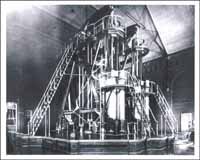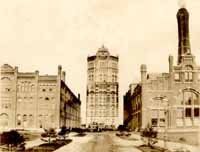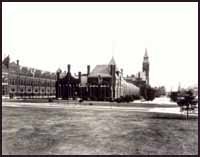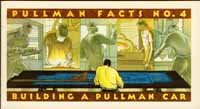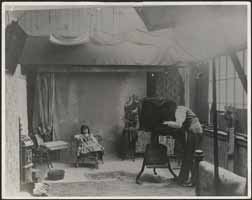The Corliss Engine
You are at Home -> The Pullman Company -> The Corliss EngineThe Great Corliss Engine
This remarkable mechanism was a simple condensing engine. It was finished in 1876 requiring seven months to build. It furnished power for running the machinery at the Philadelphia Centennial Exposition in 1876. It was purchased by George Pullman in 1880 and was moved from Providence RI where it had been in storage after the run of the Centennial Exposition to Pullman, requiring a train of thirty-five cars to transport it. It was shaped like the capital letter A and from the floor to the top of the walking beam was forty feet. The cylinders were forty inches in diameter affording a ten-foot stroke. The diameter of the crankshaft was eighteen inches and twelve feet long. The diameter of the large gear (fly) wheel was thirty feet with a face of 24 inches and was the largest gear wheel in the world. The gear wheel meshed into a pinion wheel that powered 3268 feet of main power shafting located in tunnels 4-5 feet below grade in tunnel. From the main power shaft, approximately 13,000' of overhead shafting and two miles of belting applied to the machinery in the car shop. The engine was capable of developing 2500 horsepower. When the engine was started at the Centennial exposition in Philadelphia's Fairmont Park by President Grant and Emperor Don Pedro III of Brazil, they were supported by a choir of 1000 singing Handel's Hallelujah Chorus, a band of 150 pieces playing the Centennial March composed by Richard Wagner, followed by 100 gun salute. The engine was started by Florence Pullman on April 2, 1881, and ran until the fall of 1910, when it was scrapped after electricity replaced steam as the power source. Portions of the foundation of the original engine house and power shaft tunnels located below grade are still visible on the site. The engine house at the Pullman Factory was located east (to the rear) of the North Factory wing in a room 40' square and 66' high. Wide aisles around the engine platform were providing for visitor on sight seeing tours of the factory works. The cost of engine was $77,000.THE PULLMAN HISTORY SITE

More Information About the Pullman Company
Products from the Factory
Edison Films of Pullman Travel
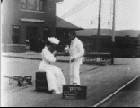
From A Romance of the Rail, 1903
Other Pullman-Related Sites
- Historic Pullman Garden Club - An all-volunteer group that are the current stewards of many of the public green spaces in Pullman. (http://www.hpgc.org/
- Historic Pullman Foundation - The HPF is a non-profit organization whose mission is to "facilitate the preservation and restoration of original structures within the Town of Pullman and to promote public awareness of the significance of Pullman as one of the nation's first planned industrial communities, now a designated City of Chicago, State of Illinois and National landmark district." (http://www.pullmanil.org/)
- The National A. Philip Randolph Pullman Porter Museum is a 501(c)3 cultural institution. Its purpose is to honor, preserving present and interpreting the legacy of A. Philip Randolph, Pullman Porters, the Brotherhood of Sleeping Car Porters and the contributions made by African-Americans to America's labor movement. ((http://www.nationalpullmanportermuseum.com/)
- Pullman Civic Organization - The PCO is a strong and vibrant Community Organization that has been in existence since 1960. (http://www.pullmancivic.org/)
- Pullman National Monument - The official page of the Pullman National Park. (https://www.nps.gov/pull/)
- South Suburban Genealogical & Historical Society - SSG&HS holds the Pullman Collection, consisting of personnel records from Pullman Car Works circa 1900-1949. There are approximately 200,000 individuals represented in the collection. (https://ssghs.org/)
- The Industrial Heritage Archives of Chicago's Calumet Region is an online museum of images that commemorates and celebrates the historic industries and workers of the region, made possible by a Library Services and Technology Act grant administered by the Illinois State Library. (http://www.pullman-museum.org/ihaccr/)
- Illinois Digital Archives (IDA) is a repository for the digital collections libraries and cultural institutions in the State of Illinois and the hosting service for the online images on this site. (http://www.idaillinois.org/)
